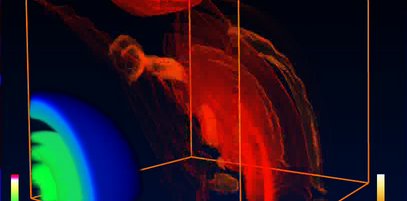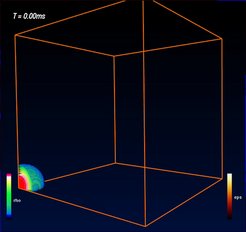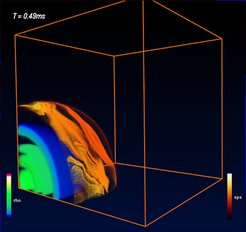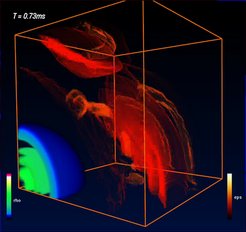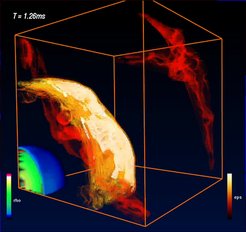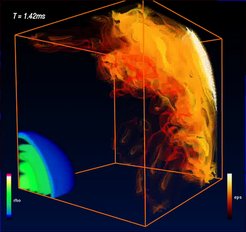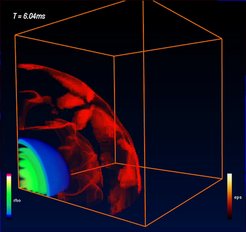Neutron star oscillations and instabilities Neutron star oscillations: unstable spherical star
These images are based on a computer simulation of an unstable spherical neutron star. Generally a neutron star can have two configurations: the stable one which corresponds to the normal neutron star, and an unstable one corresponding to a super compressed neutron star. The characteristic of an unstable equilibrium is that the smallest perturbation suffices to destabilize the system. So the spherical neutron star (visualized by its mass density), being in its unstable configuration, gets destabilized and performs heavy oscillations until it reaches the stable state as a normal neutron star. During the oscillations, shock waves are blasted into space (shown by the red-coloured internal energy).
Shown is the full 3D structure of the neutron star density (rho) and the internal energy (eps). While the neutron star itself is oscillating several times, a shock front is emitted at each of these osciallations.
Credits
© T. Font, T. Goodale, Ed Seidel (Max Planck Institute for Gravitational Physics), L. Rezzolla (Max Planck Institute for Gravitational Physics, Institute for Theoretical Physics, Frankfurt & SISSA), S. Iyer, M. Miller, W.-M. Suen, M. Tobias (Washington University), N. Stergioulas (University of Thessaloniki), W. Benger (Max Planck Institute for Gravitational Physics & Zuse Institute Berlin)
Note: Publication of these images requires proper credits and written permission. Please contact aei_zib_images@aei.mpg.de in advance of publication.
© T. Font, T. Goodale, Ed Seidel (Max Planck Institute for Gravitational Physics), L. Rezzolla (Max Planck Institute for Gravitational Physics, Institute for Theoretical Physics, Frankfurt & SISSA), S. Iyer, M. Miller, W.-M. Suen, M. Tobias (Washington University), N. Stergioulas (University of Thessaloniki), W. Benger (Max Planck Institute for Gravitational Physics & Zuse Institute Berlin)
Fig. 1
© T. Font, T. Goodale, Ed Seidel (Max Planck Institute for Gravitational Physics), L. Rezzolla (Max Planck Institute for Gravitational Physics, Institute for Theoretical Physics, Frankfurt & SISSA), S. Iyer, M. Miller, W.-M. Suen, M. Tobias (Washington University), N. Stergioulas (University of Thessaloniki), W. Benger (Max Planck Institute for Gravitational Physics & Zuse Institute Berlin)
© T. Font, T. Goodale, Ed Seidel (Max Planck Institute for Gravitational Physics), L. Rezzolla (Max Planck Institute for Gravitational Physics, Institute for Theoretical Physics, Frankfurt & SISSA), S. Iyer, M. Miller, W.-M. Suen, M. Tobias (Washington University), N. Stergioulas (University of Thessaloniki), W. Benger (Max Planck Institute for Gravitational Physics & Zuse Institute Berlin)
Fig. 2
© T. Font, T. Goodale, Ed Seidel (Max Planck Institute for Gravitational Physics), L. Rezzolla (Max Planck Institute for Gravitational Physics, Institute for Theoretical Physics, Frankfurt & SISSA), S. Iyer, M. Miller, W.-M. Suen, M. Tobias (Washington University), N. Stergioulas (University of Thessaloniki), W. Benger (Max Planck Institute for Gravitational Physics & Zuse Institute Berlin)
© T. Font, T. Goodale, Ed Seidel (Max Planck Institute for Gravitational Physics), L. Rezzolla (Max Planck Institute for Gravitational Physics, Institute for Theoretical Physics, Frankfurt & SISSA), S. Iyer, M. Miller, W.-M. Suen, M. Tobias (Washington University), N. Stergioulas (University of Thessaloniki), W. Benger (Max Planck Institute for Gravitational Physics & Zuse Institute Berlin)
Fig. 3
© T. Font, T. Goodale, Ed Seidel (Max Planck Institute for Gravitational Physics), L. Rezzolla (Max Planck Institute for Gravitational Physics, Institute for Theoretical Physics, Frankfurt & SISSA), S. Iyer, M. Miller, W.-M. Suen, M. Tobias (Washington University), N. Stergioulas (University of Thessaloniki), W. Benger (Max Planck Institute for Gravitational Physics & Zuse Institute Berlin)
© T. Font, T. Goodale, Ed Seidel (Max Planck Institute for Gravitational Physics), L. Rezzolla (Max Planck Institute for Gravitational Physics, Institute for Theoretical Physics, Frankfurt & SISSA), S. Iyer, M. Miller, W.-M. Suen, M. Tobias (Washington University), N. Stergioulas (University of Thessaloniki), W. Benger (Max Planck Institute for Gravitational Physics & Zuse Institute Berlin)
Fig. 4
© T. Font, T. Goodale, Ed Seidel (Max Planck Institute for Gravitational Physics), L. Rezzolla (Max Planck Institute for Gravitational Physics, Institute for Theoretical Physics, Frankfurt & SISSA), S. Iyer, M. Miller, W.-M. Suen, M. Tobias (Washington University), N. Stergioulas (University of Thessaloniki), W. Benger (Max Planck Institute for Gravitational Physics & Zuse Institute Berlin)
© T. Font, T. Goodale, Ed Seidel (Max Planck Institute for Gravitational Physics), L. Rezzolla (Max Planck Institute for Gravitational Physics, Institute for Theoretical Physics, Frankfurt & SISSA), S. Iyer, M. Miller, W.-M. Suen, M. Tobias (Washington University), N. Stergioulas (University of Thessaloniki), W. Benger (Max Planck Institute for Gravitational Physics & Zuse Institute Berlin)
Fig. 5
© T. Font, T. Goodale, Ed Seidel (Max Planck Institute for Gravitational Physics), L. Rezzolla (Max Planck Institute for Gravitational Physics, Institute for Theoretical Physics, Frankfurt & SISSA), S. Iyer, M. Miller, W.-M. Suen, M. Tobias (Washington University), N. Stergioulas (University of Thessaloniki), W. Benger (Max Planck Institute for Gravitational Physics & Zuse Institute Berlin)
© T. Font, T. Goodale, Ed Seidel (Max Planck Institute for Gravitational Physics), L. Rezzolla (Max Planck Institute for Gravitational Physics, Institute for Theoretical Physics, Frankfurt & SISSA), S. Iyer, M. Miller, W.-M. Suen, M. Tobias (Washington University), N. Stergioulas (University of Thessaloniki), W. Benger (Max Planck Institute for Gravitational Physics & Zuse Institute Berlin)
Fig. 6
© T. Font, T. Goodale, Ed Seidel (Max Planck Institute for Gravitational Physics), L. Rezzolla (Max Planck Institute for Gravitational Physics, Institute for Theoretical Physics, Frankfurt & SISSA), S. Iyer, M. Miller, W.-M. Suen, M. Tobias (Washington University), N. Stergioulas (University of Thessaloniki), W. Benger (Max Planck Institute for Gravitational Physics & Zuse Institute Berlin)
